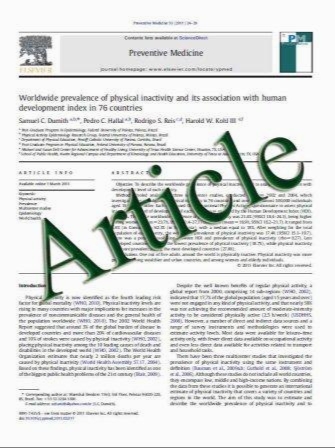Associations of objectively assessed physical activity and sedentary time with biomarkers of breast cancer risk in postmenopausal women: findings from NHANES (2003–2006)
- نوع فایل : کتاب
- زبان : انگلیسی
- مؤلف : Brigid M. Lynch Christine M. Friedenreich Elisabeth A.H. Winkler Genevie`ve N. Healy Jeff K. Vallance Elizabeth G. Eakin Neville Owen
- چاپ و سال / کشور: 2011
Description
Physical activity reduces the risk of postmenopausal breast cancer through multiple inter-related biologic mechanisms; sedentary time may contribute additionally to this risk. We examined cross-sectional associations of objectively assessed physical activity and sedentary time with established biomarkers of breast cancer risk in a population-based sample of postmenopausal women. Accelerometer, anthropometric and laboratory data were available for 1,024 (n = 443 fasting) postmenopausal women in the U.S. National Health and Nutrition Examination Survey 2003–2006. Associations of quartiles of the accelerometer variables (moderate- to vigorousintensity activity, light-intensity activity and sedentary time per day; average length of active and sedentary bouts) with the continuous biomarkers were assessed using linear regression models. Following adjustment for potential confounders, including sedentary time, moderate- to vigorous- intensity activity had significant (P\0.05), inverse associations with all biomarker outcomes (body mass index, waist circumference, C-reactive protein, fasting plasma glucose, fasting insulin and homeostasis model assessment of insulin resistance). Light-intensity activity and sedentary time were significantly associated in fully adjusted models with all biomarkers except fasting glucose. Active bout length was associated with a smaller waist circumference and lower C-reactive protein levels, while sedentary bout length was associated with a higher BMI. The associations of objectively assessed moderate- to vigorous-intensity activity with breast cancer biomarkers are consistent with the established beneficial effects of selfreported exercise on breast cancer risk. Our findings further suggest that light-intensity activity may have a protective effect, and that sedentary time may independently contribute to breast cancer risk.
Breast Cancer Res Treat DOI 10.1007/s10549-011-1559-2 Received: 25 April 2011 / Accepted: 26 April 2011


